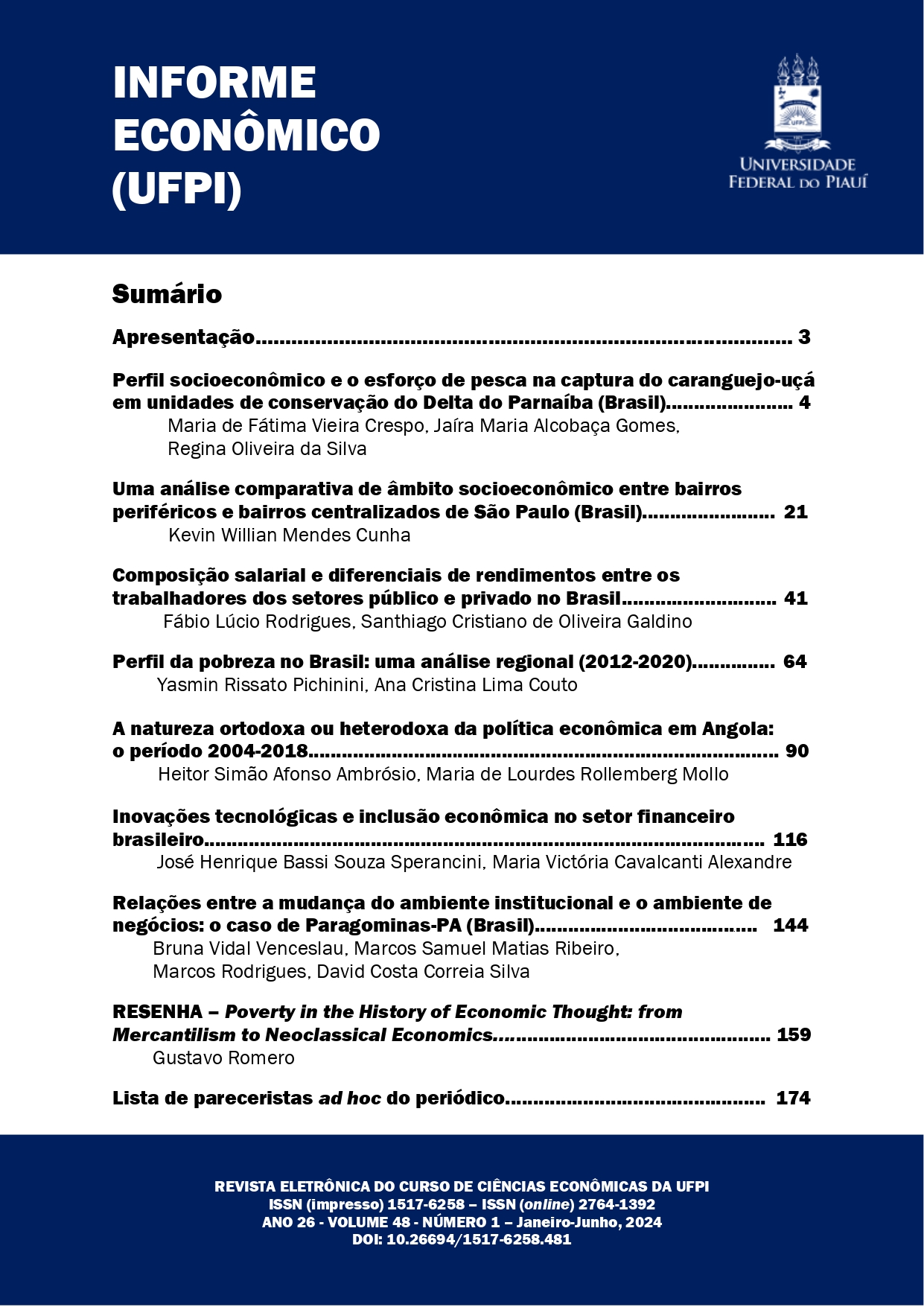Relations between the Change of the Institutional Environment and the Business Environment
DOI:
https://doi.org/10.26694/2764-1392.5522%20%20%20%20%20%20%20%20%20%20Keywords:
Mann-Whitney U test; Logging; Agricultural production; Livestock.Abstract
This paper aims to study the business environment of Paragominas, a municipality in the state of Pará that between 2007 and 2008 suffered government officials, such as the inclusion in the List of Priority Municipalities (LPM) and Operation Arco de Fogo (OAF); in addition to the Paragominas Green Municipality Project, these actions acted to combat deforestation and offer sustainable alternatives to the region's economy; as well as verifying whether the usual institutionalities in the municipality have created an institutional environment that promotes sustainable development. The study was developed from a quali-quantitative analysis. Where a survey of bibliographic material in articles, books and magazines was carried out, showing the transformations that took place in Paragominas, in the first two decades of the 21st century, taking into account the social, environmental and institutional processes experienced by the municipality; adding an analysis of statistical data on municipal agricultural production; restrictions and the labor market; Firjan Development Index; and deforestation, through a Mann-Whitney U Test. The results show that state intervention in combating deforestation in the municipality was not efficient, since the rate of deforestation remains positive, however, which refers to agricultural activities, over the past few years, it has been restructured with the decrease in cattle raising and strengthening of grain activities, such as soy and corn.
References
BÖRNER, J. et al. Direct conservation payments in the Brazilian Amazon: scope and equity implications. Ecological Economics, v. 69, n. 6, p. 1272–1282, abr. 2010.
BÖRNER, J. et al. Forest law enforcement in the Brazilian Amazon: costs and income effects. Global Environmental Change, v. 29, p. 294–305, 2014.
BRASIL. Operação Amazônia: Ministério Extraordinário para a Coordenação dos Organismos Regionais. Brasília, 1996.
BRASIL. MME. Lista de Municípios Prioritários da Amazônia. 2015.
BRASIL. Ministério do Trabalho. Relatório Anual de Indicadores Sociais (RAIS). Brasília: Brasil, 2021. Disponível em: http://pdet.mte.gov.br/acesso-online-as-bases-de-dados. Acesso em: 15 jun. 2024.
BUNO, M; NADANYIOVA, M.; HRASKOVA, D. The comparison of the quality of business environment in the countries of Visegrad group. Procedia, Economics and Finance. Elsevier, 2015.
COELHO, H. G. de A.; DOMINGUEZ, L. Diagnóstico e recomendações estratégicas numa empresa da restauração: contributos da análise de Porter, SWOT e PESTEL. FEP Economia e gestão. UPorto, 2016.
COSTA, F. de A. Elementos para uma economia política da Amazônia: historicidade, territorialidade, diversidade, sustentabilidade. Belém: NAEA, 2012.
FEARNSIDE, P. M. Soybean cultivation as a threat to the environment in Brazil. Environmental Conservation, v. 28, n. 1, p. 23–38, 2001.
FEARNSIDE, P. M. The roles and movements of actors in the deforestation of Brazilian Amazonia. Ecology and Society, v. 13, n. 1, p. 23, 2008.
FIANI, R. Cooperação e conflito: instituições e desenvolvimento econômico. Rio de Janeiro: Elsevier, 2011.
GALVÃO, Í. Da fronteira à sustentabilidade? O caso de Paragominas-PS. Belém: PPGEDAM, 2013.
INSTITUTO BRASILEIRO DE GEOGRAFIA E ESTATÍSTICA. Produção Agrícola Municipal (PAM). Rio de Janeiro: IBGE, 2021b. Disponível em: https://sidra.ibge.gov.br/pesquisa/pam/tabelas. Acesso em: 10 out. 2021.
IBGE - INSTITUTO BRASILEIRO DE GEOGRAFIA E ESTATÍSTIC. A Produção da Extração Vegetal e da Silvicultura (PEVS). Rio de Janeiro: IBGE, 2021c. Disponível em: https://sidra.ibge.gov.br/pesquisa/pevs/quadros/brasil/2022. Acesso em: 10 out. 2021.
IBGE - INSTITUTO BRASILEIRO DE GEOGRAFIA E ESTATÍSTICA. Pesquisa da Pecuária Municipal (PPM). Rio de Janeiro: IBGE, 2021a. Disponível em: https://https://sidra.ibge.gov.br/pesquisa/ppm/quadros/brasil/2022. Acesso em: 10 out. 2021.
INSTITUTO BRASILEIRO DE GEOGRAFIA E ESTATÍSTICA. Cidades e Estados: Paragominas. 2022. Disponível em: https://www.ibge.gov.br/cidades-e-estados/pa/paragominas.html. Acesso em: 15 jun. 2024.
ICSI. Environmental business and law. Prashant Vihar, New Delhi, and Printed at MP Printers. June, 2017.
FEDERAÇÃO DAS INDÚSTRIAS DO ESTADO DO RIO DE JANEIRO. Índice FIRJAN de Desenvolvimento Municipal (IFDM). Disponível em: https://www.firjan.com.br/ifdm/downloads/Rio de Janeiro: FIRJAN, 2021. Acesso em: 20 set. 2021.
INSTITUTO NACIONAL DE PESQUISAS ESPACIAIS – INPE. Projeto PRODES - Projeto de Estimativa de Desflorestamento da Amazônia. Taxas anuais do Desmatamento – 2001 até 2021. São José dos Campos: INPE, 2021. Disponível em: http://www.obt.inpe.br/prodes/prodes_1988_2016n.htm. Acesso em: 10 out. 2021.
LEAL, G. Paragominas: a realidade do pioneirismo. Paragominas: Prefeitura Municipal de Paragominas, 2000.
MELLO, N. Políticas Territoriais na Amazônia. Annablume: São Paulo, 2006.
MERRY, F.; SOARES-FILHO, B. Will intensification of beef production deliver conservation outcomes in the Brazilian Amazon? Elem Sci Anth, v. 5, p. 24, 2017.
MÜLLER-HANSEN, F. et al. Can intensification of cattle ranching reduce deforestation in the Amazon? Insights from an agent-based social-ecological model. Ecological Economics, v. 159, p. 198–211, 2019.
NEPSTAD, D. C. et al. Slowing Amazon deforestation through public policy and interventions in beef and soy supply chains. Science, v. 344, n. 6188, p. 1118–1123, jun., 2014.
NEPSTAD, D. C.; STICKLER, C. M.; ALMEIDA, O. T. Globalization of the Amazon soy and beef industries: Opportunities for conservation. Conservation Biology, v. 20, n. 6, p. 1595–1603, 2006.
NORTH, D. Institutions, institutional change and economic performance. Cambridge: Cambridge University Press: 1990.
NORTH, D. C. Instituições, mudança institucional e desempenho econômico. Trad. Alexandre Morales. São Paulo: Três Estrelas, 2018.
PANDOLFO, C. Amazônia brasileira ocupação, desenvolvimento e perspectivas atuais e futuras. Belém: CEJUP, 1994.
PINTO, A. et al. Diagnóstico socioeconômico e florestal do município de Paragominas. Relatório técnico. Belém: IMAZON, 2009.
RIVERO, S. et al. Pecuária e desmatamento: uma análise das principais causas diretas do desmatamento na Amazônia. Nova Economia, v. 19, n. 1, p. 41–66, 2009.
RIBEIRO, N. de F. A questão geopolítica da Amazônia: da soberania difusa à soberania restrita. Belém: Edufpa, 2006.
SIEGEL, S. Estatística não-paramétrica para as ciências do comportamento. São Paulo: McGraw-Hill do Brasil, 1977. 350 p.
SIEGEL, S.; CASTELLAN JR, N. J. Estatística não-paramétrica para ciências do comportamento. Artmed Editora, 2006.
SILVA, F. C. G. et al. Relatos de experiência: ações voltadas para implantação e manutenção de hortas em escola pública em Paragominas-PA com enfoque para produção sustentável através da reciclagem. In: SANTOS, C. A. dos (org.). Experiências em agroecologia. 1. ed., v. 1. Maringá: Uniedusul, 2020. p. 64-76.
Downloads
Published
Issue
Section
License
Copyright (c) 2024 INFORME ECONÔMICO (UFPI)

This work is licensed under a Creative Commons Attribution 4.0 International License.





